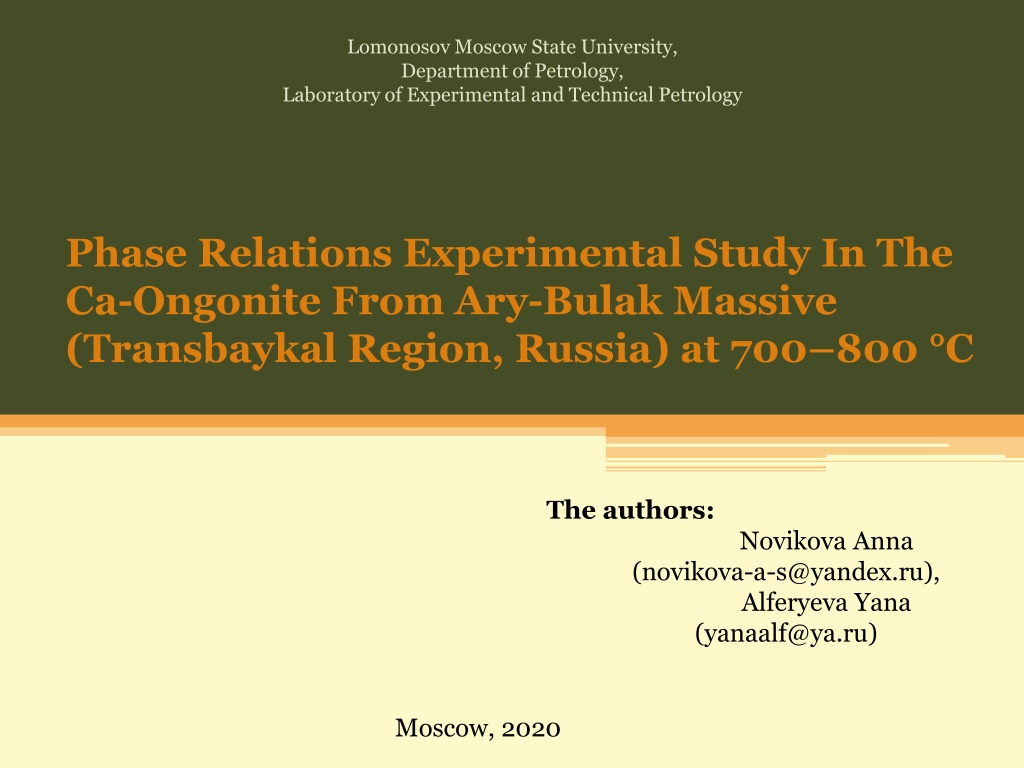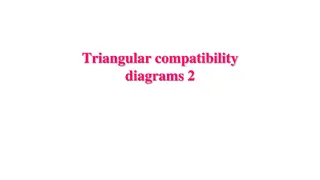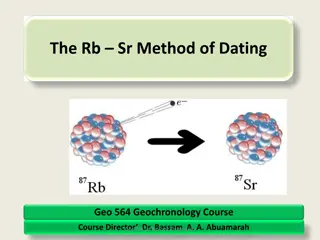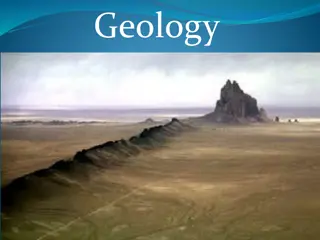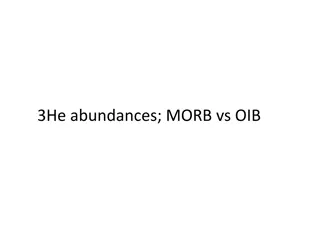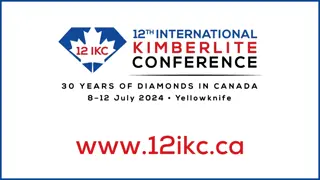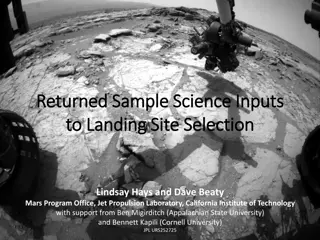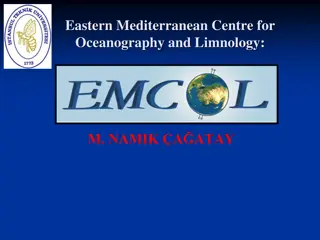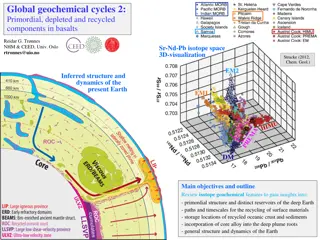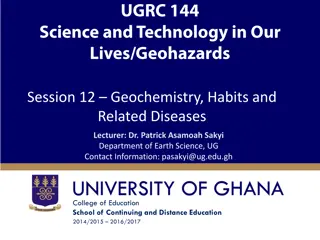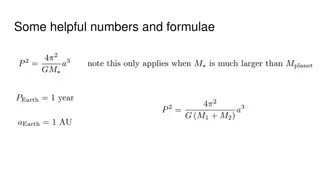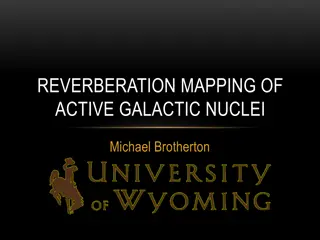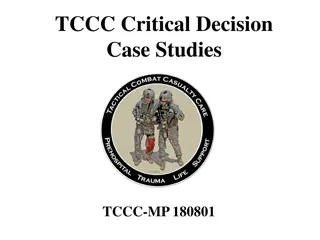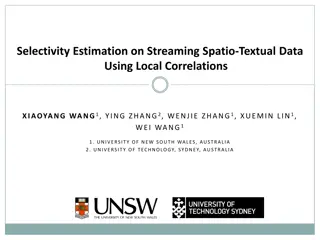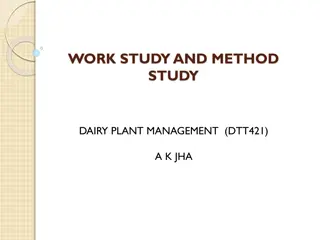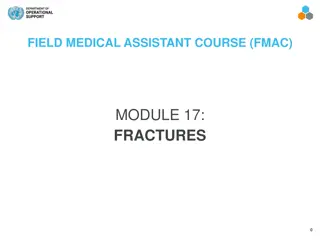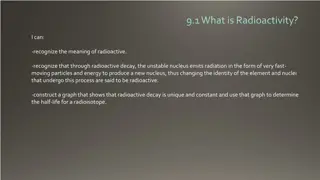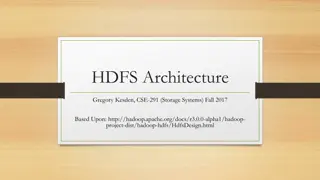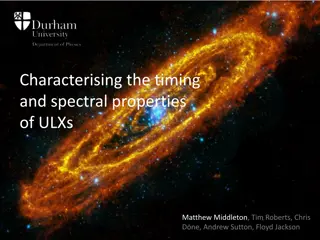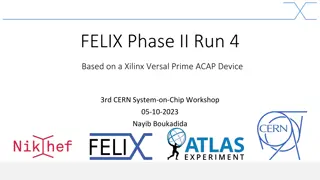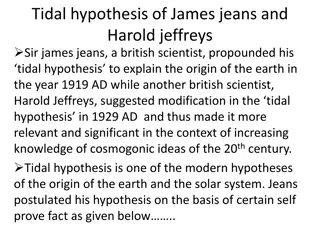Petrology and Geochemistry Study of Ongonites from Ary-Bulak Massive
Investigating the composition and crystallization of ongonites, this study conducted experiments on rocks from Ary-Bulak at varying conditions. The geological structure, facies zonation, and age of the ongonites were analyzed. Ongonites were found to be a subvolcanic analogue of rare metal LiF granites, containing minerals like Q, Kfs, Ab, and accessory minerals. The study aimed to determine the impact of water and oxygen fugacity on ongonite crystallization.
Download Presentation

Please find below an Image/Link to download the presentation.
The content on the website is provided AS IS for your information and personal use only. It may not be sold, licensed, or shared on other websites without obtaining consent from the author. Download presentation by click this link. If you encounter any issues during the download, it is possible that the publisher has removed the file from their server.
E N D
Presentation Transcript
Lomonosov Moscow State University, Department of Petrology, Laboratory of Experimental and Technical Petrology Phase Relations Experimental Study In The Ca-Ongonite From Ary-Bulak Massive (Transbaykal Region, Russia) at 700 800 C The authors: Novikova Anna (novikova-a-s@yandex.ru), Alferyeva Yana (yanaalf@ya.ru) Moscow, 2020
Introduction The main objectives of this investigation are as follows: to determine the composition of the liquidus phases and the order of crystallization; to estimate the water influence on sodification of ongonite melt; to confirm formation of a-F melts in experiments. o The main objectives of the study : o to conduct an experiment on Ary Bulak rocks at 700 and 800 Celsius degrees and pressure 1 kBar, fO2 (Ni-NiO) with different amount of water; o to determine the influence of oxygen fugacity on ongonite crystallization melt by = 750 , = 1kBar and fO2. (Mt/Hem); o to identify composition of crystalline and liquid phases
Geological structure* Ary Bulak intrusion is situated in Transbaykal Region in Russia, to south-west of Ongonite lake. Ongonite lake It forms a concentric zonal laccolith. In current erosion level is outlined as NE-SW oblong ellipse hill 900 500 m. * Geological structure is taken from article Antipin,2009 and location area has been found in Google Earth .
Geological structure The host rocks are J3 K1 Ust-Borzin rocks, such as limestones, metavolcanics, schists and sandstones. AP -28 The absolute age of ongonites was dated by the Sr-Sr method (87Sr/86Sr isotopic ratios) and is 142 0.4 Ma. [Kostisyn u. , 1998] AP -24 Ongonite lake There is a facies zonation in massive. The central zone, that occupies a large area, is composed of porphyritic ongonites, the middle zone, forming the ring-structure, 50-100 meters wide, previously consist of high Ca and F porphyritic ongonites, and the marginal zone, situated at the southwestern flank of massive, is composed of aphyric rocks. AP -19 porphyritic ongonites Irkutsk Chita high Ca-F ongonites Ary Bulak 50 aphyric ongonites 120 110 * Information about geological structure is taken from article Antipin,2009 and location area has been found in Google Earth .
Petrology and geochemistry of ongonites ngonites subvolcanic analogue of rare metal Li F granites Minerals: Q (50%), Kfs(35%), Ab (5%), Toz Fl. The groundmass structure is microlitic. Accessory Minerals: Ilmenite, Rutile, galena, columbite-tantalite, wolframite It contains SiO2 - from 68 to 73%, Al2O3 -14-19%, and are quite sodic (K2O+Na2O = 8,05 9,47) Q Ab Thin section of ongonite* White prozopite veins in aphyric ongonite** * Picture is taken from Peretyazhko, I.S., 2009 **Is taken from https://webmineral.ru/deposits/item.php?id=4502
Ongonites Ongonites form small subvertical dikes, that crosscut stratification in a stratified sequence, or is roughly vertical in an unstratified sequence and series of lodes from 3 to 30 sm.* .2. .[ ,2011] granites .3 . [ ,2013] rock .4 (1) (2).[ ,2013] Scree ignimbrite debris in ongonites Biotitic granite xenolith in ongonite Ongonite dike in biotitic * For more information [V.I. Alekseev,2013]
Petrology and geochemistry of Ary Bulak ongonites Ary Bulak porphyric ongonite mineral composition conforms to normal ongonite composition, but differ from the last one in phase proportion. The central zone: Porphyric ongonites. Phenocrysts (40%): Q (45%), Kfs(20%), Ab (30%). The groundmass (60%) contains isometric Q grains, tabular Ab crystals, rimmed with K- feldspar and elongated acicular Toz crystals in glass. The middle zone: Ca-F rich porphyric ongonites Phenocrysts (40%) : Q (50%), Kfs(15%), Ab (25%), Mica (5%), Toz (5%). The groundmass (60%) contains submicrometric fluoritic and K-feldspathic phases. 100 90 80 Toz 70 Minerals, % Mu 60 Kfs 50 The marginal zone: Aphyric ongonites Phenocrysts (10%): Q (60%), Kfs(10%), Ab (30%). The groundmass (90%) mostly consist of prosopite. (26 wt %). Intestitions are filled with elongated acicular Toz crystals and fluoritic and K-feldspathic phases. 40 Pl 30 Q 20 10 0 AP -19 -24 -28 Phenocrysts mineral composition in Ary Bulak ongonites
Petrography of the Ary Bulak ongonites 1). -19 2). -24 3). -28 1- . Q, Pl, Kfs in aphyric ongonite 2- . Q, Pl, Kfs, Toz in Ca-F porphyritic ongonite 3- . Q, Pl, Kfs in porphyritic ongonite. 1-b. Globe-shapedfluorite inclusion in aphyric ongonite 2-b. Dumbbell-like fluorite crystals in quartz in Ca-F porphyritic ongonite 3-b. Globe-shaped fluorite inclusion in porphyritic ongonite Here Q - Quartz; Pl Feldspar; Kfs - Potassium feldspar; To Topaz; Fl - Fluorite
Geochemical characteristics of rocks F, CaO decreasing from boundary to center rocks SiO2 SiO2 increasing from boundary to center rocks CaO CaO F F Porphyritic ongonites are equal to normal ongonites from Ongon-Hayerkhan with aO<0,5 mass% and amount of F 1,15 mass%.[Peretyazhko, I.S., et al., ,2010]. In boundary aphyric rocks F and CaO amount increaces from 5,2 to 18,8 mass% and from 5,4 to 22 %.
AS diagram Classical ongonites Ary Bulak ongonites
Experimental studies of ongonite systems Fusion range of typical ongonites (550 870 ) Crystallization sequence (with H2O): Albite ->Quartz -> Potassium feldspar -> Topaz -> Mica In excess of (HF) the order of crystallization changes to: Quartz-> Topaz Model experiments had shown the expanding of Q- field in higher F activity systems. [Kovalenko, 1979, Kovalenko, 1976, Manning, 1981].
Experimental studies of Ary-Bulak ongonite systems (by Peretyazhko I.S) Fluid and melt inclusions are situated in Q. Their exploration has shown the existence of Ca-F melt.* The calcium fluoride and residual aluminosilicate melts coexisted at a temperature below the transition of quartz (595 585 C). The magmatic crystallization of quartz began at a temperature not lower than 750 650 C. The residual glass starts to melt at 450 500 C and became liquid at 700 750 C and even 1000 1050 C . Ca-F melt inclusions in Q and melt (MI) and syngenetic gas-rich fluid inclusions (FI) * [Peretyazhko, I.S., et al., 2007a, Peretyazhko, I.S., et al., 2007b, Peretyazhko, I.S., et al., . 2010]
Other Ca-F founded inclusions* Ca-F inclusions in pegmatites and adjacent subsolvus granites (two alkali feldspars) of the Mid- Proterozoic Strange Lake pluton (Quebec-Labrador, Canada) gl A BSE image of Ti-rich silicate glass containing a globule of calcium-rich fluoride glass with a high concentration of the REE. A BSE image of inclusion containing silicate melt, zircon crystals and a fluid bubble. Geological map of the Strange Lake pluton showing the distribution of the principal rock types, the locations of the pegmatite-rich areas * [Vasyukova O. et all, 2014]
Experiment 1: melting rocks at T = 800 and 700 , P = 1 kBar, buffer Ni-NiO
The experimental method. Instrumentation : analytical balance, arc welding set, hydrothermal cold seal pressure vessels, binocular microscope. Source material: three powders of three types of rocks from marginal ( 19), middle ( 24) and central ( 28) zone. Termodinamical parameters: Termodinamical parameters Water,% sample experiment Samples from three different zones were explored at the temperatures 700 and 800 Celsius degrees and pressure 1 kBar at different amount of water 3, 5 10 per cent on hydrothermal high-pressure plant. -19 -24 -28 849 850 851 839 842 855 840 841 852 853 854 859 860 861 3% -19 T=800 C; p = 1kBar 10% -24 -28 -19 -24 -28 -19 -24 -28 Experiments (800 C) have lasted 7 days, and at 700 C 14 days. 15% T=700 C; p = 1kBar 10%
Experiment 2: melting rocks at T = 750 , P = 1 kBar, buffer Mt-Hem
The experimental method. Instrumentation : analytical balance, arc welding set, binocular microscope, IHPV ( gas bomb ) Source material: two powders of two types of rocks from marginal ( 19) and middle ( 24) zone. chemical reagent Fe2O3 ( ACS) , natural magnetite powder, distilled water Termodinamical parameters: =750 , 1 kBar, fO2. (Mt/Hem). Experiment have lasted 2 days.
Binary ampoules method Method principle: External ampoule Internal ampoule Internal ampoule containing buffer mixture in Mt/Hem proportion 1:9 is places inside external ampoule containing the same buffer mixture in the same Mt/Hem proportion. With temperature rises the chemical reaction between Mt and Hem is going on. The determined oxygen fugacity has been established upon the reaction completion. H2 Small amp. 1 Fe2O3+Fe3O4 Small amp. 2 H2 migration results in ampule heat in gas bomb. Small ampoules: ongonite powder+distilled water Fe2O3+Fe3O4 Internal and external ampoule: buffer Mt/Hem + distilled water 3 Fe2O3 + H2 = 2 Fe3O4 + H2O.
Binary ampoules method log(??2) = ? ? + ? +?(? 1) ? fO2 oxygen fugacity (atm), , , thermodynamical constants, temperature ( ), pressure (Bar) Oxygen fugacity (fO2) determination in experiments on IHPV. Point on the figure is a theoretically calculated oxygen fugacity for Mt-Hem buffer under determined experimental parameters.
Analysis procedure X-ray diffraction methods measured such components as (Si, Al,Ti, Mg, Fe, Mn, Na, Ca, K, F, O, Cl, Ba, Nb, Ta, Sr, W, Sc) Acquisition parameters: I- 0,7 nA, U - 20 v. Standarts: for glass- Plagioclase, for fluorite fluorite ICP MS bulk composition for all elements determination ( Li ,Sc , Ti ,V ,Cr ,Mn ,Co ,Ni ,Zn ,Rb, Sr ,Y, Zr, Nb ,Cd ,Sn ,,Sb ,Cs,,Ba,La,Ce, Pr ,Nd ,Sm ,Eu ,Gd ,Tb ,Dy ,Ho ,Er ,Tm ,Yb, Lu, Hf,Ta, W,Pb ,Th, U ) Electron probe micro-analyzer - bulk composition for general elements determination (SiO2, TiO2 ,Al2O3, Fe2O3, MnO ,MgO, CaO,Na2O, K2O, P2O5). Measurement error- (5 ppm) ICP-MS
Chemical composition Glasses composition Sample Bulk compositi on Buffer SiO2 Al2O3 Na2O K2O CaO F O=2F Sum2 52,23 18,64 0,46 3,11 14,79 7,31 3,08 94,06 800 Ni-NiO 67,51 14,26 0,77 5,1 1,99 3,7 1,56 91,77 -19 750 Mt-Hem 67,72 13,77 0,22 4,08 1,44 3,02 1,27 88,98 700 Ni-NiO 68,04 14,79 0,26 4,42 2,59 2,85 1,2 91,75 Bulk composi tion 62,78 14,83 3,44 3,96 9,85 3,56 1,5 97,74 800 Ni-NiO 66,97 15,16 3,21 4,29 1,74 2,31 0,97 92,7 -24 750 Mt-Hem 68,27 14,77 1,81 4,13 1,13 2,25 0,95 91,4 700 Ni-NiO 70 13,91 1,59 4,31 1,56 1,52 0,64 92,25 Bulk composi tion 71,86 16,86 3,89 4,5 0,17 1,83 0,77 99,04 -28 800 Ni-NiO 700 Ni-NiO 71,36 71,18 14,14 14,49 3,46 2,76 4,66 4,6 0,17 0,22 0,74 0,96 0,31 0,4 94,23 93,82
Phase relationships -28 -24 -19 800 Ni-NiO L L, Flu, Tpz L, Flu, Tpz, Qz 750 Mt- Hem - - L, Flu, Tpz L, Flu, Tpz, Qz 700 Ni-NiO L L, Flu, Tpz, Pl L, Flu, Tpz, Qz, Pl
Phenocrysts composition T=800 C, P=1 kbar T=750 C, P=1 kbar T=700 C, P=1 kbar 120 120 120 100 100 100 Al-phase Flu Toz Mu Q gl Al-phase 80 80 Proportion,% Proportion, % 80 Flu Proportion, % Flu Toz Toz 60 60 60 Q Pl Q 40 gl 40 40 gl 20 20 20 0 0 0 AP -19 -24 -28 AP -19 -24 AP -19 -24 -28 Here Q - Quartz; Pl Feldspar; Mu- Mica; Toz Topaz; Flu Fluorite; Al-phase high Al hardened phase; gl glass.
Summarizing results F 7 6 5 4 3 2 1 SiO2 SiO2 50 55 60 65 70 75 -28 -19 -24 Inherent composition . L 800 L 700 L by 700 C L by 800 C Variation in F/SiO2 ratio with temperature decrease (800-750- 700 ).
Conclusions Conducted experiments didn t reproduce phase relationships in Ary Bulak rocks. This data shows that Ca-F melt is not stable at predetermined conditions. Liquidus phases for high Ca-F ongonites are fluorine and topaz. Variability in oxygen fugacity didn t affect phase relationships significantly.
Conclusions The middle and marginal zone liquidus temperature is higher than 800 C. That is not typically for F-riched granites. Only Ca-poor porphyric ongonites measure up normal liquidus conditions conforming temperatures below 700 C.
Conclusions General trend in crystallization of ongonite melt is directed towards F content decrease in residual liquid and alkalies and silicium increase. It shows that the mechanism of crystal differentiation doesn t appreciably represent naturally formed mineral association.
Literature sources Antipin, V.S., Andreeva, I.A., Kovalenko, V.I. and Kuznetsov, V.A. (2009) Geochemical specifics of ongonites in the Ary- Bulak Massif, eastern Transbaikalia. Petrology, 17, 558 569. V.I.Alekseev., Ongonitic magmatism of the badzhalsky ore district (Amur river region), Geology and metallogeny, Saint Petersburg, 2013 , P.114-125 Kostisyn u. . Age and genesis of thc spodumene-bearing granites of the SW Altai (Russia): isotopic and geochemical study // Acta Unirversitatis Carolinae-Geologica. 1998. . 42. . 60-63. Kovalenko N. I. , Experimental Study of the Formation of Rare Metal Li-F Granites (Nauka, Moscow, 1979) [in Russian]. Kovalenko V. I. and Kovalenko N. I. , Ongonits (Nauka, Moscow, 1976) [in Russian] Manning D.A.C. The effect of fluorine on liquidus phase relationships in the system Qz Ab Or with excess water at 1 kb // Contr. Miner. Petrol., 1981, v. 76, p. 206 215. Peretyazhko, I.S. and Savina, E.A., Fluid and magmatic processes in the formation of the Ary-Bulak ongonite massif (eastern Transbaikalia), Russ. Geol. Geophys., 2010d, vol. 51, no. 10, pp. 1110 1125. Peretyazhko I.S., Zagorsky, V.E., Tsareva, E.A., and SapozhnikovaA.N. Immiscibility of calcium fluoride and aluminosilicate melts in ongonite from the Ary-Bulak Intrusion, Eastern Transbaikal Region, Dokl. Earth Sci., 2007a, vol. 413, pp. 315 320. Peretyazhko, I.S., Tsareva, E.A., and Zagorsky, V.E., A first finding of anomalously Cs-rich aluminosilicate melts in ongonite: evidence from melt inclusion study, Dokl. Earth Sci., 2007b, vol. 413A, pp. 462 468. Vasyukova, O. and Williams-Jones, A.E., Fluoride silicate melt immiscibility and its role in REE ore formation: evidence from the Strange lake rare metal deposit, Qu bec Labrador, Canada, Geochim. Cosmochim. Acta, 2014, vol. 139, pp. 110 130. https://webmineral.ru/deposits/item.php?id=4502
